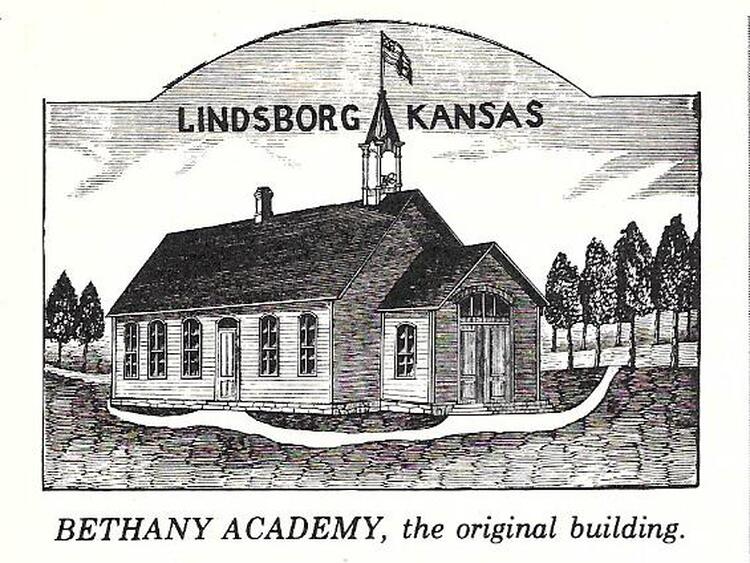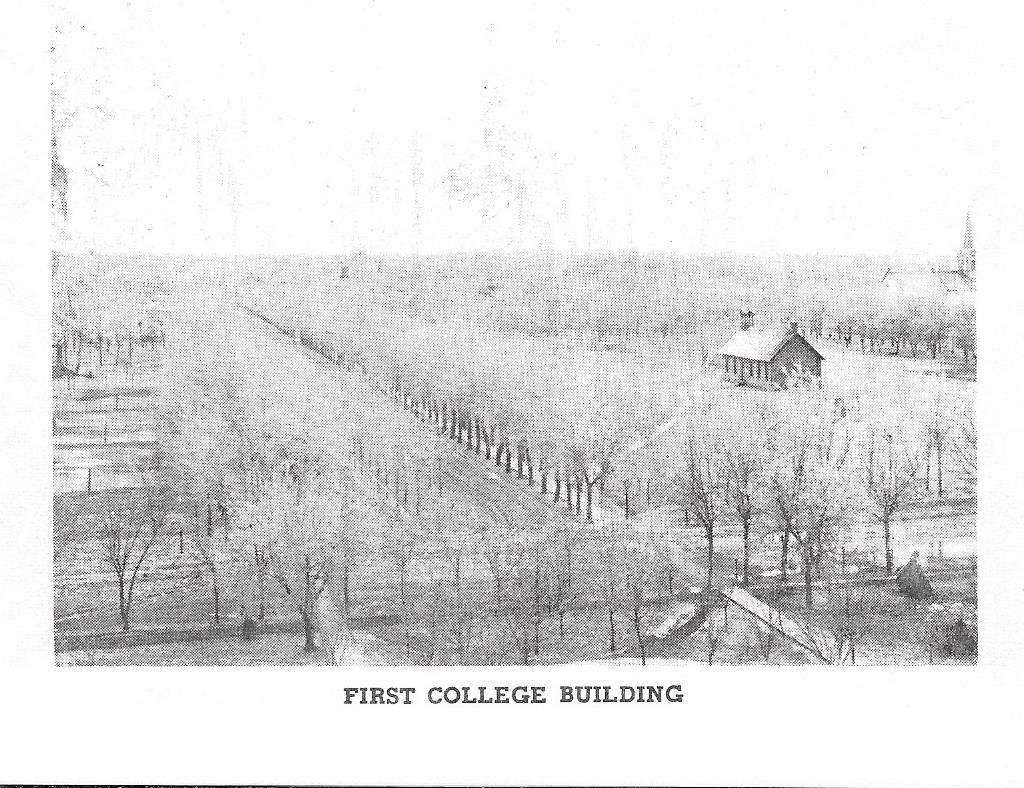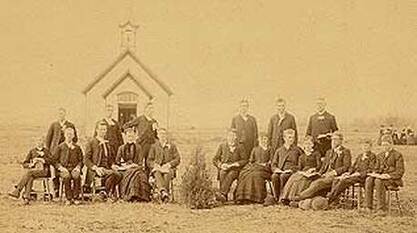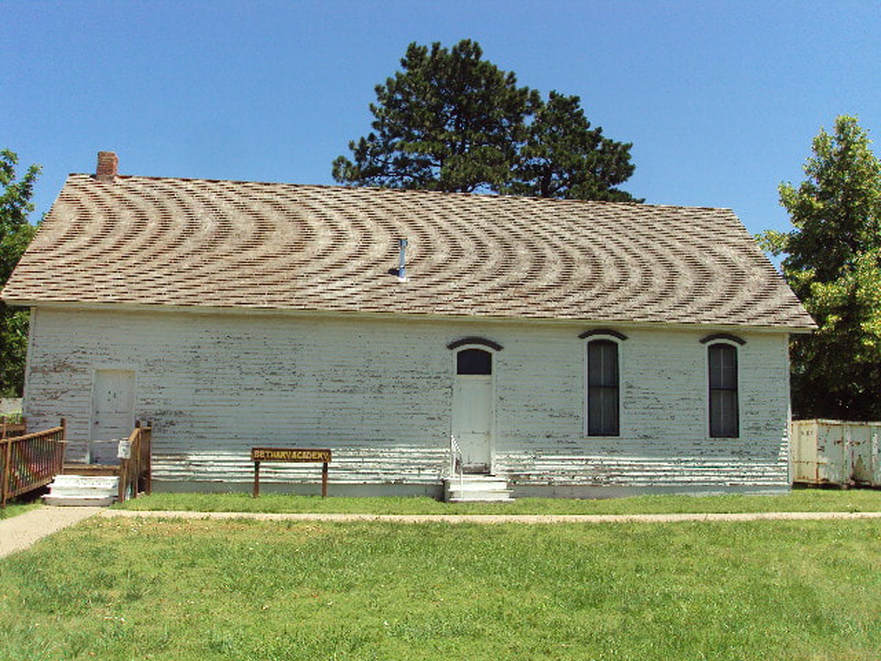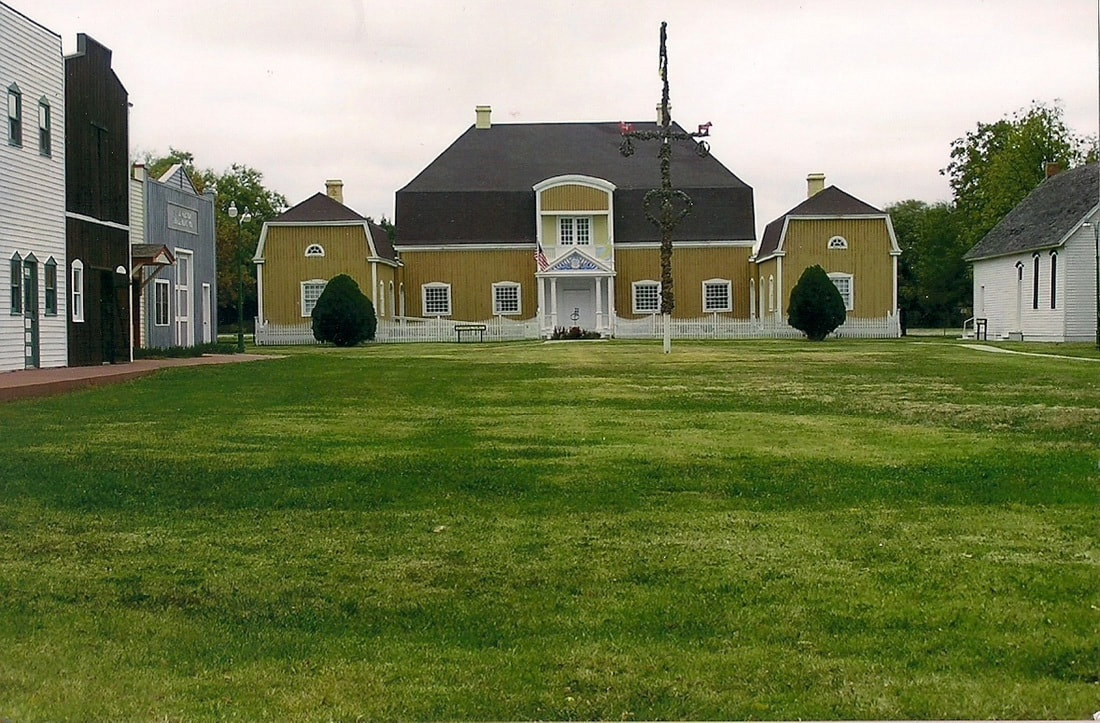Scientist Emil O. Deere
(Deere & Lydia's Bethany -- Lydia's Photography, 1906 - 1925)
(Deere & Lydia's Bethany -- Lydia's Photography, 1906 - 1925)
* * *
- To remember this "key" Swedish American "Bethany College Building" is to look back on Bethany's very beginnings -
- It is to remember the "Bethany Family" of its era. -
Many people had to stand outside the Academy Building.
The Bethany Cornet Band played and the Salemsborg Quartette sang Swedish songs. …
The entire dedicatory program and the act of dedication was in Swedish.
-- Smoky Valley News, 1882
- To remember this "key" Swedish American "Bethany College Building" is to look back on Bethany's very beginnings -
- It is to remember the "Bethany Family" of its era. -
Many people had to stand outside the Academy Building.
The Bethany Cornet Band played and the Salemsborg Quartette sang Swedish songs. …
The entire dedicatory program and the act of dedication was in Swedish.
-- Smoky Valley News, 1882
Bethany College "Bethany Academy" 1882 -- Swensson's Bethany's Beginnings
~ Not photographed by Lydia
~ Not photographed by Lydia
- The Bethany Academy building was at the very heart of the Bethany College beginnings -
Bethany was chartered by the State of Kansas in September 1882
It was dedicated by Founder Carl Aaron Swensson with Augustana Synod leaders presiding on October 4, 1882
It was adopted as "the child" of the Augustana Synod in 1884 at the Kansas Conference at Mariadahl Lutheran Church
In the following excerpts from fourth Swedish American Bethany College President Emory Lindquist's 1975 book, Bethany in Kansas, the history of a college, Chapter 1, "Founding and Early Years, 1881 - 1991," Lindquist brings us to the very time of the way it was from the start of Bethany College.
From pages 5 and 7 Lindquist writes:
"The Lindsburg Localist [a Lindsborg newspaper with a different spelling for Lindsborg] recognized the potential importance of "Swensson's school" in an article in June, 1882: 'There is an enterprise underway here that should not be forgotten by our people, namely the Lutheran Bethany Academy. No enterprise could be of greater importance to the city. Talk it up.' The editor had reported on March 23 that another city in Kansas, apparently McPherson on the basis of other sources, had offered $10,000 as an inducement to move Bethany Academy there. The Localist expressed concern on June 15: "Efforts are being made continually by competing towns to have the academy moved there. Lindsborg could not well afford to lose the academy." The Smoky Valley News observed solemnly in November, 1882, when commenting about the Lindsborg institution: "We also have the Lindsborg Academy under the supervision of the [local] Lutheran Church, a project that will be of great benefit to our city."
"The encouraging response to the new school provided the incentive for the developments that occurred in 1882. The [Lindsborg] public school house, which had been purchased by Swensson, was moved to the "park" which had been donated by the Bethany congregation. A 16' x 24' addition was built to the school house and the area was then divided into three classrooms, one larger and two smaller. A small steeple to hold a bell was added. In July, 1882, the Smoky Hill District of the Kansas Conference of the Augustana Lutheran Synod pledged its congregations and members to support the new school. The following members of a board of directors were elected: The Reverends J. Seleen, A.W. Dahlsten, P. M. Sanquist, and C.A. Swensson and Messrs. Charles Strömquist, J. Thorstenberg, John A Swenson, and Andrew Lincoln.
- The Bethany Academy -
in Bethany Park, flanked by College Street on the left and Bethany Lutheran Church on the right
in Bethany Park, flanked by College Street on the left and Bethany Lutheran Church on the right
- Before there were trees on the Campus and in Lindsborg -
Third Graduating Class
Third Graduating Class
"The first meeting of the board was held on August 30, 1882. Pastor Sanquist opened the meeting with prayer. Carl Swensson was elected chairman, A. W. Dahlsten, secretary, and John A. Swenson, treasurer. The first action was authorization for Swensson to start a subscription of funds for the school. ...
"A charter of Bethany Academy was authorized by the State of Kansas in September, 1882. Bethany Academy was dedicated at festive services on October 4, 1882. The Smoky Valley News reported: "One of the most interesting events in the history of Lindsborg is undoubtedly the dedication of Bethany Academy. Many people had to stand outside the Academy Building." The Bethany Cornet Band played and the Salemsborg Quartette sang Swedish songs. Addresses were given by the Reverends Carl Swensson, J. Seleen, and S.P.A. Lindahl. The entire dedicatory program and the act of dedication was in Swedish. When the program at the Academy Building was concluded, the band escorted the entire audience to the Tremont House where dinner was served. Exercises in the evening were scheduled for the Academy Building, but the crowd was too large and the wind was too strong for the Chinese lanterns that were to provide illumination, so the festivities were moved to the Bethany Church."
"A charter of Bethany Academy was authorized by the State of Kansas in September, 1882. Bethany Academy was dedicated at festive services on October 4, 1882. The Smoky Valley News reported: "One of the most interesting events in the history of Lindsborg is undoubtedly the dedication of Bethany Academy. Many people had to stand outside the Academy Building." The Bethany Cornet Band played and the Salemsborg Quartette sang Swedish songs. Addresses were given by the Reverends Carl Swensson, J. Seleen, and S.P.A. Lindahl. The entire dedicatory program and the act of dedication was in Swedish. When the program at the Academy Building was concluded, the band escorted the entire audience to the Tremont House where dinner was served. Exercises in the evening were scheduled for the Academy Building, but the crowd was too large and the wind was too strong for the Chinese lanterns that were to provide illumination, so the festivities were moved to the Bethany Church."
Quoting from the Bethany Academy Catalogue of 1883-84 in his Bethany in Kansas, Lindquist writes on page 11, the following:
"The motto of Bethany Academy was "Christo et Ecclessiae" ("For Christ and the Church"). The catalogue emphasized the religious commitment as follows: 'Salvation by a personal living faith in a Divine Savior is recognized by the authorities of this school as the chief truth in human knowledge. Religious instruction not only forms a part of the daily routine of the school, but every endeavor is also made to surround the student with a healthy religious atmosphere. It is the desire and purpose of both the board of directors and faculty to consecrate the institution to the highest interest of the kingdom of Christ on earth." An appeal to students and their parents from out-of-town was made in these words: "While Lindsborg is free from many of the temptations to vice of large cities, it affords nearly all of their social and educational advantages. This portion of Kansas is noted for its general healthfulness of climate, an important consideration for the student.'
"The year 1884 witnessed a decisive event when the Kansas Conference of the Augustana Lutheran Synod, meeting at Mariadahl Lutheran Church, near Cleburne, Kansas, passed the following resolution:
'Whereas, Bethany Academy, through its board of directors asks the Conference for its support and protection, be it resolved that the Conference adopt Bethany as its child and that its charter be changed in accordance therewith.
'Resolved, that Smoky Hill, Clay Center, and the East districts constitute Bethany Academy's territory, from which its support should be forthcoming.' "
"The motto of Bethany Academy was "Christo et Ecclessiae" ("For Christ and the Church"). The catalogue emphasized the religious commitment as follows: 'Salvation by a personal living faith in a Divine Savior is recognized by the authorities of this school as the chief truth in human knowledge. Religious instruction not only forms a part of the daily routine of the school, but every endeavor is also made to surround the student with a healthy religious atmosphere. It is the desire and purpose of both the board of directors and faculty to consecrate the institution to the highest interest of the kingdom of Christ on earth." An appeal to students and their parents from out-of-town was made in these words: "While Lindsborg is free from many of the temptations to vice of large cities, it affords nearly all of their social and educational advantages. This portion of Kansas is noted for its general healthfulness of climate, an important consideration for the student.'
"The year 1884 witnessed a decisive event when the Kansas Conference of the Augustana Lutheran Synod, meeting at Mariadahl Lutheran Church, near Cleburne, Kansas, passed the following resolution:
'Whereas, Bethany Academy, through its board of directors asks the Conference for its support and protection, be it resolved that the Conference adopt Bethany as its child and that its charter be changed in accordance therewith.
'Resolved, that Smoky Hill, Clay Center, and the East districts constitute Bethany Academy's territory, from which its support should be forthcoming.' "
In Lindquist's Chapter 17 -- Alumni Remember, page 267, of his Bethany in Kansas, is a memory which recalls that of the "first" Bethany College building:
"Dr. Julius Lincoln, a native of Lindsborg, recalled that summer day in 1882 when he watched the old Lindsborg public school house placed on rollers. He walked expectantly with many spectators to the future campus of Bethany Academy where the old frame structure became the first building. Ten years later he was a member of the first baccalaureate graduating class of four members. His temple of memory always included the living and distinct portrait of Bethany's founder, Carl Swensson, and his dynamic words for that day and later: "Kunskap är makt" -- 'Knowledge is power.' …"
"Dr. Julius Lincoln, a native of Lindsborg, recalled that summer day in 1882 when he watched the old Lindsborg public school house placed on rollers. He walked expectantly with many spectators to the future campus of Bethany Academy where the old frame structure became the first building. Ten years later he was a member of the first baccalaureate graduating class of four members. His temple of memory always included the living and distinct portrait of Bethany's founder, Carl Swensson, and his dynamic words for that day and later: "Kunskap är makt" -- 'Knowledge is power.' …"
* * *
" Bethany Academy Building "
- The Bethany Academy sign was removed in 2013 and it is identified as Lindsborg's "First School House" -
- Today located at the McPherson County Old Mill Museum Heritage Park. -
" Bethany Academy Building "
- The Bethany Academy sign was removed in 2013 and it is identified as Lindsborg's "First School House" -
- Today located at the McPherson County Old Mill Museum Heritage Park. -
Today the Bethany Academy building is showcased exclusively as Lindsborg's First School House of 1879. As explained to me in emails from the McPherson County Old Mill Museum, this building actually played two roles in "education." Initially it served as the "First School House" of Lindsborg in 1879. Three years later, in 1882, it was moved to the future college campus and became known as the "First College Building" and was named Bethany Academy. Eighty-seven (87) years later, in 1969, it was moved from the Bethany College Campus to the McPherson County Old Mill Museum Heritage Park. Erected in front of it was the Bethany Academy sign.
In 2013, the decision was made by the McPherson County Old MIll Museum to create an exhibit to reflect the building's "first and original" identity as the "1879 first public school building in Lindsborg." Thus, the Bethany Academy building sign was taken away and the historic early college memorabilia and artifacts on display within it were returned to the Bethany College Archives, and the building was repainted.*
Since that time, this "first" most important building of Bethany College has had no visual connection with the institution it first served and has had no historical linkage of importance to its role of becoming a real functional school for the Bethany Academy, for our Bethany College.
The McPherson County Old Mill Museum reported in 2018 that one day this building will be promoted as a building of dual historical educational importance to both Lindsborg and the College to include "new exhibits that encompass the entire history of the structure from its conception to the current day."** This will then restore its true historical Swedish and Swedish American significance of Swensson's Bethany College's Bethany Academy beginnings of 1882. A letter was written to the Museum to follow up on this in 2019 to see if the status had changed. There was no reply, which would imply that no further attempt has been made to identify this most important first College building to the Bethany College.
In 2013, the decision was made by the McPherson County Old MIll Museum to create an exhibit to reflect the building's "first and original" identity as the "1879 first public school building in Lindsborg." Thus, the Bethany Academy building sign was taken away and the historic early college memorabilia and artifacts on display within it were returned to the Bethany College Archives, and the building was repainted.*
Since that time, this "first" most important building of Bethany College has had no visual connection with the institution it first served and has had no historical linkage of importance to its role of becoming a real functional school for the Bethany Academy, for our Bethany College.
The McPherson County Old Mill Museum reported in 2018 that one day this building will be promoted as a building of dual historical educational importance to both Lindsborg and the College to include "new exhibits that encompass the entire history of the structure from its conception to the current day."** This will then restore its true historical Swedish and Swedish American significance of Swensson's Bethany College's Bethany Academy beginnings of 1882. A letter was written to the Museum to follow up on this in 2019 to see if the status had changed. There was no reply, which would imply that no further attempt has been made to identify this most important first College building to the Bethany College.
* * *
- On the right can be seen some of the "Bethany Academy" building which is located next to the "Swedish Pavilion" -
- These two buildings served Bethany College's needs over 100 years ago. -
In 1969 they left the Bethany College Campus for good and were relocated to the Swedish-type open air museum,
the McPherson County Old Mill Museum Heritage Park.
* Information from McPherson County Old Mill Museum April 27, 2018.
** Information from McPherson County Old Mill Museum July 25, 2018.
** Information from McPherson County Old Mill Museum July 25, 2018.
* * *
- To remember this "key" Swedish American "Bethany College Building" is to look back on Bethany's very beginnings -
- It is to remember the "Bethany Family" of its era. -
* * *
"Let Us Celebrate Them"
* * *
Swedes: TheWayTheyWere
~ restoring lost local histories ~
reconnecting past to present
* * *
All color photography throughout Swedes: The Way They Were is by Fran Cochran unless otherwise indicated.
Copyright © since October 8, 2015 to Current Year
as indicated on main menu sections of
www.swedesthewaytheywere.org. All rights reserved.
- To remember this "key" Swedish American "Bethany College Building" is to look back on Bethany's very beginnings -
- It is to remember the "Bethany Family" of its era. -
* * *
"Let Us Celebrate Them"
* * *
Swedes: TheWayTheyWere
~ restoring lost local histories ~
reconnecting past to present
* * *
All color photography throughout Swedes: The Way They Were is by Fran Cochran unless otherwise indicated.
Copyright © since October 8, 2015 to Current Year
as indicated on main menu sections of
www.swedesthewaytheywere.org. All rights reserved.
